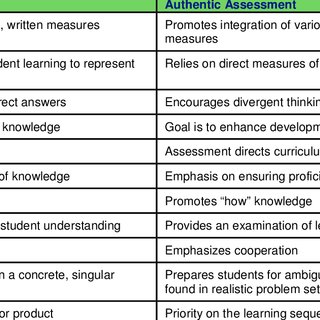CATs and other informal assessment tools provide key information during the semester regarding teaching and learning so that changes can be made as necessary. These methods include but are not limited to observations anecdotal notes and records text- and curriculum-embedded questions and tests paper-and-pencil tests computer adaptive and on-line tests oral questioning benchmarks.

Traditional Vs Authentic Assessment Methods Download Table
Assessments should not be used to threaten students with grades.

. Classroom Assessment Techniques CATs Classroom Assessment is a systematic approach to formative evaluation used by instructors to determine how much and how well students are learning. It is a simple approach that generally utilizes a pen and paper or computer-based examination method which constitutes a similar pattern of questions such as Multiple Choice true and false or matching items. This assessment gives you a picture of misconceptions and confusion that still exists in the students minds.
Improving the reliability of teachers summative assessment I. Summative assessment by teachers is the process by which teachers gather evidence in a planned and systematic way in order to draw inferences about their studentslearningbased on their professional judgmentand to report at a particular time on their studentsachievements. You can quickly check for understanding.
Constructive The assessment should provide constructive information for both the teacher and the students. That is their strengths and weaknesses. Diagnostic literacy assessments typically involve the use of standardized tests administered individually to students by highly trained educational specialists such as reading teachers special educators speech and language pathologists and school psychologists.
To assess the attainment of the objectives Teacher A required the students to construct a bar graph for the given set of data then she asked them to interpret this using a set of questions as guide. Traditional assessments generally involve the use tests quizzes and homework as the means for evaluation. In RTI three types of assessments are used.
Teacher B presented a bar graph then asked them to interpret this using also a set of guide questions. Teacher-designed quizzes and tests Writing Presentations for audiences Technical creations for audiences Technical creations for audiences Interviews and conferences Portfolios Self and peer evaluations Learning logs Journals Kinesthetic. Most formative assessment strategies are quick to use and fit seamlessly into the instruction.
Universal screening to determine which students need closer monitoring differentiated instruction or a specific intervention n 3 times a year 2. The majority of assessments in educational settings are formal. This assessment provides students with a metacognitive opportunity to think about their own learning.
On the contrary assessments should be used to inspire students to perform better. Types of Assessment in Education. Common formal assessment formats used by teachers are multiple choice matching and truefalse items.
And assessments should not be used to threaten teachers with scores. Traditional assessments ask how. These tools typically assess low-level literal questions and specific skills.
Formative assessment is more diagnostic than evaluative. Formal assessments on the other hand are preplanned systematic attempts by the teacher to ascertain what students have learned. Students can increase their understanding of their own learning.
Traditional tests make the focus less on learning and deep level thinking and more towards memorization and repetition. Progress monitoring to determine if. Formal-summative-traditional assessments measure and strengthen the students cognitive abilities to recallmemorize comprehend and reconstruct knowledge addressing the lower level cognitive skills from knowledge to comprehension while the informal-formative-alternative assessments measure and strengthen the students higher level of cognitive skills.
Diagnostic assessments let you understand your students academic readiness and learning needs. It is used to monitor pupil learning style and ability to provide ongoing feedback and allow educators to improve and adjust their teaching methods and for students to improve their learning. A conventional method of assessment that has been followed since a long time is the traditional assessment.
When determining which assessments you will use to measure learning outcomes it can be helpful to have an. Teachers who evaluate students may use to acquire assessment data and information. There are several types of assessments in education.
Why Should I Consider Using Learning-Oriented Assessment. Learning-Oriented assessment is assessment that has the purpose of bringing about deep and meaningful learning for student. In selected response items students have to select a response provided by the teacher or test developer rather than constructing a response in their own words or actions.
This is a course-based type of assessment that focuses on students learning rather than instructors teaching. Each one comes with a unique set of methods and serves different purposes.

Traditional Vs Authentic Assessment Methods Download Table

Defining Features Of Traditional And Authentic Assessment Print Version

0 Comments